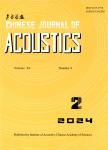Calculation of vibrational energy transition rates in acoustic relaxation processes for excitable gas molecules
Calculation of vibrational energy transition rates in acoustic relaxation processes for excitable gas molecules作者机构:School of Electrical and Information Engineering~ Guizhou Institute of Technology Guiyang 550003 School of Electronic Information and Communications Huazhong University of Science and Technology Wuhan 430074 School of Big Data Guizhou Institute of Technology Guiyang 550003
出 版 物:《Chinese Journal of Acoustics》 (声学学报(英文版))
年 卷 期:2018年第37卷第2期
页 面:202-218页
核心收录:
学科分类:07[理学] 070203[理学-原子与分子物理] 0702[理学-物理学]
基 金:supported by the National Natural Science Foundation of China(61461008,61371139,61571201,61540051) the China Scholarship Council Project(201708525058) the National Science Foundation of Guizhou Province,China(Qian Ke He J Zi2065),Qian Ke He LH Zi7361) the Recruitment Program of Guizhou Institute of Technology(XJGC20140601,XJGC20150107)
主 题:Calculation of vibrational energy transition rates in acoustic relaxation processes for excitable gas molecules
摘 要:To research the correlation between vibrational energy transition rates and acoustic relaxation processes in excitable gases, the vibrational relaxation theory provided by Tanczos [J. Chem. Phy3. 25, 439 (1956)] is applied to calculate the energy transition rates of Vibrational- Vibrational (V-V) and Vibrational-Translational (V-T) energy transfer in gas mixtures. The results of calculation for the multi-relaxation processes in various gas mixtures, consisting of carbon dioxide, methane, chlorine, nitrogen, and oxygen at room temperature, demonstrate that the acoustic energy stagnated in every vibrational mode is coupled with each other through V-V energy exchanges. The vibrational excitation energy will relax through the V-T de-excitation path of the lowest mode because of its fastest V-T transition rate, resulting in that only one absorption peak can be measured for most of excitable gas mixtures. Thus, an effective model is provided to analyze how the vibrational energy transition rates affect the characteristics of acoustic relaxation processes and acoustic propagation in excitable gas mixtures.



